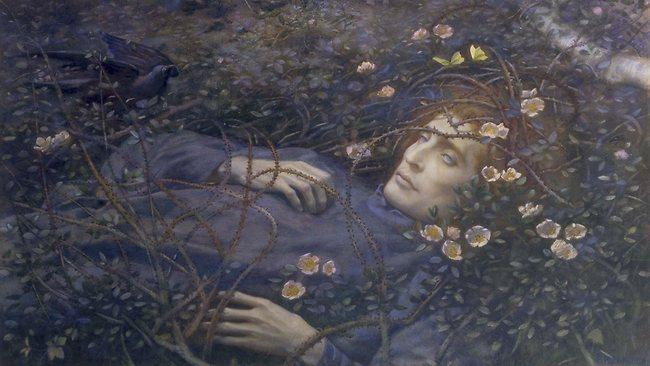Awkward grace of Pre-Raphaelites
VISUAL ART: The Poetry of Drawing: Pre-Raphaelite Designs, Studies and Watercolours. Art Gallery of NSW, Sydney. Until September 4.

VISUAL ART: The Poetry of Drawing: Pre-Raphaelite Designs, Studies and Watercolours. Art Gallery of NSW, Sydney. Until September 4.
THE Pre-Raphaelite movement got bad press in the early 20th century. It tended to be lumped in with everything a new generation disliked about the Victorian period: the realism, the moralism, the compulsory seriousness at which Oscar Wilde poked fun in his most famous comedy, The Importance of Being Earnest (1895), and that Lytton Strachey so brilliantly dissected in Eminent Victorians (1918).
More recently, Pre-Raphaelite artists have had a revival both in their critical and popular fortunes. A fundamental survey, The Pre-Raphaelites, at the Tate Gallery in 1984 awakened critics and historians to the need for a reappraisal, and numerous studies have since been written on individual figures.
More recently, a television series devoted to the lives and loves of the group revealed a complicated, passionate, often tormented set of relationships behind the appearance of Victorian moral stodginess.
In spite of the ups and downs in their reputation, a certain number of Pre-Raphaelite pictures have always been among the most strangely emblematic of the British 19th-century. These are images that stick in your mind whether you particularly like them or not: Dante Gabriel Rossetti's cowering Virgin in Ecce Ancilla Domini! (1849), John Everett Millais' slowly and almost voluptuously drowning Ophelia (1852) or William Holman Hunt's Christ eerily lit from below by the glow of his lantern in The Light of the World (1854).
A century ago, in 1906, Hunt's third version of this extraordinarily famous composition arrived in Sydney as part of a world tour and was shown at the Art Gallery of NSW. More than 12,000 people visited the picture on each of the 25 days of the exhibition, apparently still an unbroken record for attendances at an exhibition in this country.
These events are recalled in the opening room of an outstanding exhibition that comes to the AGNSW from the Birmingham Museum and Art Gallery.
The Poetry of Drawing, as the title suggests, presents a selection of Pre-Raphaelite drawings, including illustration and design, but above all concentrates on what the artists' approach to drawing reveals about their style in general.
The Pre-Raphaelite Brotherhood, the first important movement of this kind in British art, was formed in 1848 by a group of young artists who were dissatisfied with the academic approach to art teaching. Instead of volume and modelling, they preferred linear drawing in the tradition of John Flaxman's neo-classical illustrations of Homer, published at the end of the 18th century.
Instead of the sfumato continuity of surfaces, they returned to hard edges; and instead of pictorial compositions constructed in areas of light and dark (chiaroscuro), they preferred the whole scene to be evenly lit.
In all of these respects they reversed the reforms of the high renaissance, which in fact began with Leonardo, although they became general and canonic in the work of Raphael, hence the name Pre-Raphaelite.
In their drawings, the Pre-Raphaelites sought to represent the truth of nature in the most literal way, avoiding the generalisation and imaginative synthesis that were recommended in traditional theory but sometimes degenerated into mannerism.
At the same time, they reduced their figures to precise yet often almost flat outlines; the combination of literalism and stylisation is distinctive and sometimes uncomfortable, while the overall effect recalls book illustration, a natural application for such a graphic style.
In their pursuit of truth - and of a truth to contemporary experience - the Pre-Raphaelites adopted certain kinds of models in preference to others; they were notorious even at the time for weedy male and scrawny female figures.
No doubt in an effort to escape the cliched attitudes of conventional painting, they seem to have sought more vernacular postures and gestures: the kinds of things people around them did, even if they were not what figures in paintings were usually seen doing.
In the end, this is one of the least successful aspects of the style: hence the collection of mincing, affected, clumsy or simply silly attitudes that mar various pictures, from chewed lips and bitten fingers to crossed legs and pointed feet. Millais' Isabella (1848-49) is an anthology of awkwardness that it is still hard to look at without wincing.
On the other hand, some of these stylistic idiosyncrasies undeniably evoke aspects of English experience at the time. The Long Engagement (c. 1858) by Arthur Hughes, is an almost painfully vivid image of frustrated desire.
The young curate who is too poor to marry and his blonde fiancee are pale and bloodless, hollow-eyed with longing; they are surrounded by an exquisitely but almost absurdly detailed forest scene, alive with the colours of spring. In the background two red squirrels are a tantalising image of togetherness; life is easy without the constraints of economic status, respectability and religious guilt.



